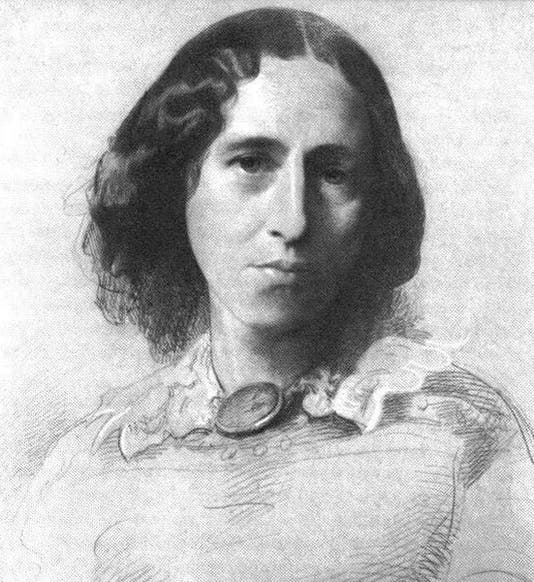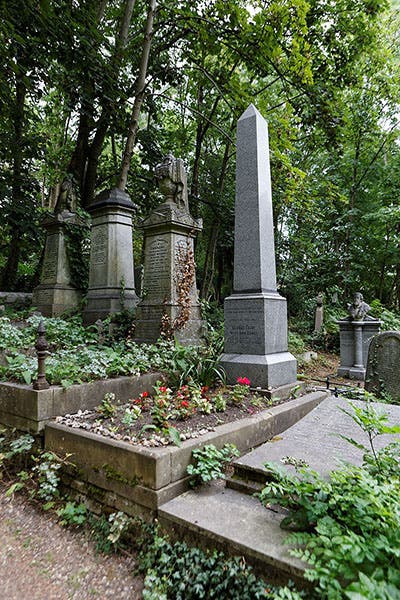Scientist of the Day - George Eliot
Mary Ann Evans (or Marian Evans), an English novelist better known as George Eliot, was born Nov. 22, 1819. Evans came from a provincial family in Warwickshire, then Coventry; she was well-educated by tutors and gradually came to sympathize with dissenters and free-thinkers in matters of religion. She moved to London in 1850 and went to work for the Westminster Review, which she effectively edited. She met a philosopher, Geoge Henry Lewes, who would eventually become her common-law husband; they lived together until his death in 1878.
In the mid-1850s, Evans began writing novels. While editing the Westminster Review, she had criticized fiction written by women in England as pseudo-romantic fluff, and she made the case for deeper, more thoughtful, realistic writing. She put those thoughts into practice in her own writing, setting her novels in provincial regions. with real people and their very real problems. There is not a tinge of Romantism in Evans’ work.
Her first full novel was Adam Bede (1859, beating Charles Darwin’s Origin of Species to the press by a few months). She took the name George Eliot in order not to put too much strain on her illicit relationship with Lewes, although her identity soon became known, and eventually the couple was accepted into polite society, not that they sought such acceptance. Since we are writing about her novels, we will use the name George Eliot for the rest of this post.
Adam Bede was followed by Silas Marner (1860) and The Mill on the Floss (1861). Eliot wrote 7 novels in all. The sixth was Middlemarch, issued in 8 parts in 1871-72 (nearly all novels of the day were issued as serials, but 8 parts was unusual – this was a formidable novel). Middlemarch is considered by many critics to be her greatest creation. On that I cannot comment, as I have read only Silas Marner and Middlemarch. But it is fortunate for us that Eliot wrote Middlemarch; otherwise, she would not have made it into the ranks of Scientist of the Day. For in this novel, Eliot gave the reading public its first glimpse of a physician who is not a quack, inserted for comic relief, but rather a well-educated, concerned individual, with a desire to reform current medical practice. We should mention that the novel is set in the period 1829-32, which was one of the great Ages of Reform in English history.
That physician is Tertius Lydgate, the first educated medical doctor in all of English literature. He could not be more different from his literary predecessors, Dr. Slop (Laurence Sterne), Dr. Slammer (Charles Dickens), and Dr. Fillgrave (Anthony Trollope), who were all charlatans. In the few prior novels that did feature more reputable physicians, their medical practice was totally incidental to the plot. Tertius Lydgate was different; he was aristocratic by birth (although not by inclination or financial situation), well-educated and conversant with all the sciences, and passionately interested in medical reform; his medical ideas, moreover, were integral to the story. Lydgate was a follower of Xavier Bichat, the great French pathologist who first established the tissue as the central element in the body, with each tissue susceptible to its own diseases and dysfunctions. Lydgate wanted to institute Bichat’s reforms in the clinic in Middlemarch (we show the page in the novel where Bichat is introduced, from the original first printing, fourth image). Lydgate wanted to set up an infection ward where persons with infectious diseases were isolated from the rest of the hospital population. He wanted to put an end to cupping and bleeding as mainstays of country medical practice. He wanted to reform medicine the way others were seeking to reform electoral practice, voting rights, and the poor laws.
Lydgate is flawed, of course, like all of Eliot’s characters; he falls into the wrong relationship with the beautiful but uninspiring Rosamond, and all his medical training does not teach him how to work with conservative country doctors without turning them against him, or how to assess character. He does not end up being a great medical or social success in the novel. But Eliot did manage to show readers of Middlemarch that medicine in England had come a long way from the antiquated practice of the 1820s, and that (presumably) the medicine of the 1870s, the age of the germ theory of disease and antisepsis, had similar giant steps to take.
After Lewes died in in 1878, Evans remarried a younger man in 1880, becoming Mary Ann Cross, but she died later that same year, of kidney disease. She is buried in Highgate Cemetery (East) in London, next to her beloved Henry (fifth image). Highgate East is not rich in scientists, which is surprising, since it had a special section for dissenters and unbelievers (that is why Evans and Lewes are there). But if you search diligently, avoiding the eyes of a bronze Karl Marx, you can find memorials to sociologist Herbert Spencer, mathematician William Kingdon Clifford, portraitist George Richmond (who did Charles Darwin’s wedding portrait), and zoological artist Joseph Wolf.
There are many portraits of George Eliot, mostly from the 1860s. We like the pencil sketch with which we began this post (first image).
Dr. William B. Ashworth, Jr., Consultant for the History of Science, Linda Hall Library and Associate Professor emeritus, Department of History, University of Missouri-Kansas City. Comments or corrections are welcome; please direct to ashworthw@umkc.edu.










